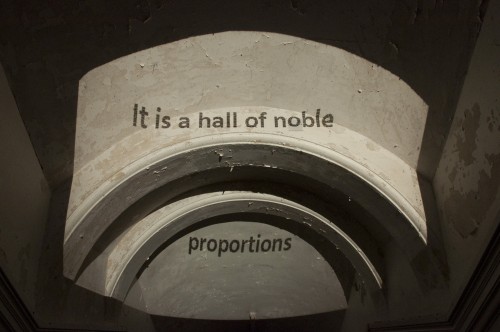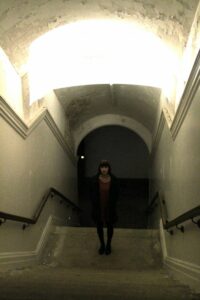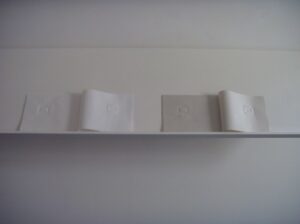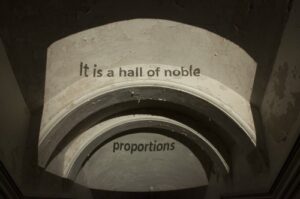

Name: Rebecca Travis
Location: Newcastle-Upon-Tyne
Website: https://rebeccatravis.tumblr.com/
Brief artists statement:
My work is fundamentally an investigation and response to surface and material. This has taken many forms, from responding directly to an architectural space and its surfaces, to creating surfaces through immersive 35mm slide projection installations, combining both tangible and intangible media to transform surface appearance and invoke ‘tactile fantasy’.
In addition to this, a continuing series of books archive processes used in my installation and drawing practice. These books are purely visual and specifically document the material nature of paper, its fragility, ephemerality and beauty in its ‘destruction’ by putting the pages through a series of repetitive processes. They act as a contrasting accompaniment to the projection works, providing a materially tangible and more intimate viewing experience.
How did you become an artist? Did you always dream of a life in the art-world?
I have been creative as long as I remember and through a little nurturing through school and outside projects I realized that art was what I wanted to do at university. I have been graduated almost a year now and am continuing working through my studio and critical writing practice.
How has your education helped your career?
I suppose in effect it helped me start the whole thing. I really credit two teachers who I had at GCSE level. I had started to find art very boring as we studied the same artists year after year, then they came in and we started learning about more contemporary artists: Gary Hume, The Boyle Family, Kiki Smith and it just ignited a spark of interest again. It taught me that art could be anything; it wasn’t restricted to painting, sculpture and drawing.
Do you work as an artist full-time? Describe your typical day. Do you have a routine?
I work part time as a gallery assistant at BALTIC Centre for Contemporary Art and fit my studio practice around that. My studio is at the NewBridge Project (https://thenewbridgeproject.com/) an old office block that has been converted into exhibition and studio space. When I have a studio day I like to go in for about 11am, I get all the morning light so the space is always bright and warm by that time and it’s a really lovely environment to work in. The work that I’m making will depend on the project that I’m doing, and I often use the space to write in too.
Which historical and contemporary artists do you refer to most often? How are you influenced by their work?
This really varies from project to project. At the moment I’m really enjoying the architectural references in the work of Martin Boyce, the lo-fi mechanics of Lazlo Maholy Nagy and the photography of Thomas Demand.
What are the other influences on your work?
Architecture constantly informs my work – the way light and shadow play within it and responding to its various surfaces.
Also film, in particular Ingmar Bergman, Andrei Tarkovsky and Alfred Hitchcock for their use of lighting in scenes.
Books and literature are a really important influence. Ones that I always come back to tend to focus on the philosophy of aesthetics, in particular Eyes of the Skin: Architecture and the Senses, In Praise of Shadows and Wabi Sabi: The Japanese Art of Impermanence.

What was the last exhibition you visited?
The most recent one was the preview of Malerei: Painting as Object at the NewBridge Space. The last one I visited outside of Newcastle was Thomas Demand at Nottingham Contemporary; his photographs of architectural models are stunning.
What is your favourite art gallery?
This really depends on the exhibitions and general feel of the place. I liked the Neue Gallery in Berlin and the A Foundation in Liverpool though I think that’s closed down now. A lot of the time it’s more interesting to see art outside of a gallery context. There’s been a movement in using empty shop fronts, disused warehouse spaces and crumbling buildings and often they can be much more atmospheric than a white cube gallery space.
What are your experiences of the ‘art-world’ and the business of art?
It can be a pretty tough and elitist environment to try and crack into and often it comes down to who you meet and the exchange of ideas to get things going. Newcastle has an interesting arts scene that is really gathering momentum but it’s intimate enough that you get to know the same faces who appear at previews/exhibitions and events. As an emerging artist it’s a good artist community to be a part of as opportunities flow quite freely between people and organizations and there’s a very personable feel to it.
Do you have any tips or advice you wish you had known earlier in your career?
I am at a pretty early stage in my career so any tips would be welcome.
Do you have a quotation that you keep coming back to and that keep you going?
“Deep shadows and darkness are essential, because they dim the sharpness of vision, make depth and distance ambiguous, and invite unconscious peripheral vision and tactile fantasy”
Juhani Pallasmaa, The Eyes of the Skin: Architecture and the Senses.
This is a quote from one of my favourite books The Eyes of the Skin: Architecture and the Senses. It really beautifully en-captures how light and shadow play with surface and the imagination to create a sense of intrigue and interest. It’s written as a response to architecture but I find it relates to all areas of my practice.
Have you a motto that gets you through?
Not a motto as such but make opportunities for yourself, seek out exhibitions to apply for, put on shows and be pro-active.
Which historical artist do you think is over-rated? Why?
I think most recognized artists have a place in history for a reason. Even if I’m not a particular fan of their work often they had an interesting idea or ideology behind it that gives them a deserved place in art history.
Do you or would you use assistants to make your work?
At the moment I don’t need assistants to make my work, as it is relatively small-scale and my own hand within the artwork is an important aspect of my practice. If I had an idea for something much bigger and more complex it would make sense to consult contacts and assistants who are better informed to help create parts of that vision, however it would always be important to me to be intrinsically part of my work’s creation process.
Do you use social networks? if so, how and which ones do you find most useful?
I have recently started to use Twitter as a means not only to generate more interest around my work but also to stay in the loop about residencies, artist opportunities, jobs and exhibitions that other people tweet about. I never realized how useful it could be as a means to network and keep informed with what’s going on, you can tweet me @travis_rebecca.

Which artist should we all look up immediately? What art magazines, blogs or sites should art lovers be looking at?
There are a couple of interesting art journals and magazines based in the North East that I recommend. One is CANNED magazine (https://cannedmagazine.com/) – a discursive art journal I write for that covers both specific art topics and wider contexts. Another is Corridor 8, also based in the North East.
Finish this limerick:
There once was an artist from… the toon who worked by the light of the moon, she worked all night to get the piece just right and will exhibit it very soon.
Poetry is not my strong point.

Leave a Reply